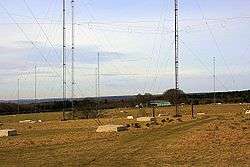GCHQ Scarborough
| GCHQ Scarborough | |
|---|---|
| Part of Government Communications Headquarters | |
| Located near Scarborough, North Yorkshire, United Kingdom | |
|
Aerials, Irton Moor Part of the wireless station known as 'GCHQ Scarborough' | |
 GCHQ Scarborough Location in North Yorkshire | |
| Coordinates | 54°16′01″N 0°26′50″W / 54.26694°N 0.44722°WCoordinates: 54°16′01″N 0°26′50″W / 54.26694°N 0.44722°W |
| Type | Satellite Ground Station |
| Site history | |
| Built | 1914 |
GCHQ Scarborough is a satellite ground station located on Irton Moor, on the outskirts of Scarborough in North Yorkshire, England, operated by the British signals intelligence service (GCHQ).
History
The Royal Navy first established a Wireless Telegraphy Station in Scarborough in 1912.[1] Since 1914, it has conducted signal intelligence (Sigint). During the First World War, the station's purpose was to monitor the German High Seas Fleet which was making attacks on the East Coast of England. Following the cessation of hostilities in 1918, the role of the station was widened to include diplomatic communications, with resources eventually being split between the diplomatic and the naval aspects. In 1932, a proposal was made to close the Scarborough station and transfer its duties to RAF Flowerdown in Hampshire, but eventually this proposal was turned down and the station resumed operations in 1935.[2]
At the outbreak of the Second World War, the Scarborough station was classified as a Y-station. It intercepted German naval and naval air communications, and also controlled a direction finding network. The station's complement became a mix of civilian members of the Admiralty Civilian Shore Wireless Service (ACSWS) and service personnel, to be augmented by members of the Women's Royal Naval Service later in the war. In May 1941, the station played a central role in the location and sinking of the Bismarck, for which they were later thanked by then-Prime Minister Winston Churchill.[2][3]

The station moved to its present location in 1943, which at the time was a "half-buried bomb-proof bunker". Following the end of the Second World War and the beginning of the Cold War, the station became the main station for the interception of Soviet naval communications. In 1965, ACSWS was transferred to the control of the Government Communications Headquarters (GCHQ), and became part of a network known as the Composite Signals Organisation (CSO). The station became known as CSOS Irton Moor.[2]
Work on a new building began in 1972 and all operations had been transferred from the "bunker" to the new building by 1974. Following the fall of the Iron Curtain in the early 1990s, the role of Sigint in the UK became less important, and the functions of both GCHQ Cheadle and GCHQ Culmhead were transferred to Scarborough in 1995 and 1998, respectively. In July 2001, the site name changed to GCHQ Scarborough.[2]
In 2014, the station celebrated their centenary, and were visited by Charles, Prince of Wales. The site is considered the longest continuously-running Sigint station in the world.[4]
References
- ↑ "Do you want to know the secrets of GCHQ?". The Scarborough News. 25 June 2016. Retrieved 26 June 2016.
- 1 2 3 4 "A short history of Sigint at Scarborough". GCHQ. Retrieved 31 October 2015.
- ↑ "Secret base opens for Ray". Scarborough News. 27 October 2004. Retrieved 31 October 2015.
- ↑ "Prince of Wales' visit for Scarborough's GCHQ station". BBC News. 30 July 2014. Retrieved 31 October 2015.
